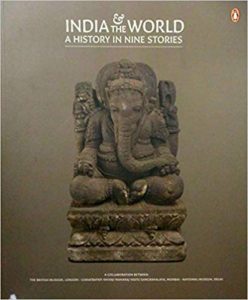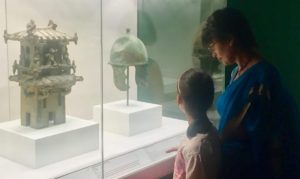‘India and the World: A History in Nine Stories’
 In May a two-month exhibition opened at National Museum, New Delhi. It had been curated by Naman P. Ahuja and Jeremy David Hill. The introduction to the catalogue is by Neil MacGregor, Former Director, British Museum. The premise of the exhibition to give a narrative of the history of India with the world in nine stories. It was intended to be told through a careful selection of significant objects that would represent this incredible relationship through the ages. The curation of the exhibition took more than three years. The idea of using objects to tell the history is a methodology made popular by Neil MacGregor when he curated an exhibition called “A History of the World in 100 Objects“.
In May a two-month exhibition opened at National Museum, New Delhi. It had been curated by Naman P. Ahuja and Jeremy David Hill. The introduction to the catalogue is by Neil MacGregor, Former Director, British Museum. The premise of the exhibition to give a narrative of the history of India with the world in nine stories. It was intended to be told through a careful selection of significant objects that would represent this incredible relationship through the ages. The curation of the exhibition took more than three years. The idea of using objects to tell the history is a methodology made popular by Neil MacGregor when he curated an exhibition called “A History of the World in 100 Objects“.
For some these narratives of distilling world cultures and stories into objects is a convenient way of mapping centuries of history. It also provides a new generation a visual experience of the past while providing crucial landmarks by mapping significant objects. But objects represent partly tell the story. Try doing the exercise for contemporary settings and see how many qualifiers you come up with. It is a challenging process. More so in an age where identity politics are becoming more and more critical and who is responsible for the discourse.
By attempting to tell world history narratives through a series of disparate objects presumes a bedrock of  information and knowledge that is sadly lacking among many. Or curate such an exhibition but then provide sufficient modes of engagement that supplement the main narrative. Provide audio towers. Interactive kiosks. Computer screens for browsing through the online exhibition. Use augmented reality to recreate scenarios and settings of these objects. Even The Print‘s report on the exhibition had some constructive feedback.
information and knowledge that is sadly lacking among many. Or curate such an exhibition but then provide sufficient modes of engagement that supplement the main narrative. Provide audio towers. Interactive kiosks. Computer screens for browsing through the online exhibition. Use augmented reality to recreate scenarios and settings of these objects. Even The Print‘s report on the exhibition had some constructive feedback.
 information and knowledge that is sadly lacking among many. Or curate such an exhibition but then provide sufficient modes of engagement that supplement the main narrative. Provide audio towers. Interactive kiosks. Computer screens for browsing through the online exhibition. Use augmented reality to recreate scenarios and settings of these objects. Even The Print‘s report on the exhibition had some constructive feedback.
information and knowledge that is sadly lacking among many. Or curate such an exhibition but then provide sufficient modes of engagement that supplement the main narrative. Provide audio towers. Interactive kiosks. Computer screens for browsing through the online exhibition. Use augmented reality to recreate scenarios and settings of these objects. Even The Print‘s report on the exhibition had some constructive feedback.The Braille touch was a fantastic idea but badly implemented. Why were the legends for instance of the palm placed in the next room rather than next to the cubicle displaying the original? It’s a genuflection. Sure it’s meant for the visually impaired but some individuals can actually have a sense of light. Lecdems happened but were not sufficiently well publicized. I heard about the exhibition because of Twitter and the publisher who mentioned the book online.
The catalogue mentions that the exhibition was for educational purpose. It definitely is educational more like a school exhibition helping plot markers by building appropriate mental furniture in a school going kids mind! I have an eight year old daughter who is brought up on a fare of books and documentaries and frank conversations. Our parenting styles are clear. Let the child come to us and our communication channels be open rather than her be misinformed. So we sit with her and watch documentaries. Explain things. So the moment she saw the bust of Hadrian she squealed with delight. She had recognised Hadrian. For much else if I had not been with my daughter giving a running commentary on the objects helping her connect dots with her many experiences, snatches from bookish references, stories told, films watched, conversations had, the child would have been terribly confused and bored! Instead she ran round and round the exhibition trying to click pictures.
Saving grace was watching the child run around enthusiastically. If that is the impact then the exhibition I would say it’s a success for it caught the imagination of the future generation. That is what matters!!!
To buy the paperback on Amazon India
14 August 2018

No Comments